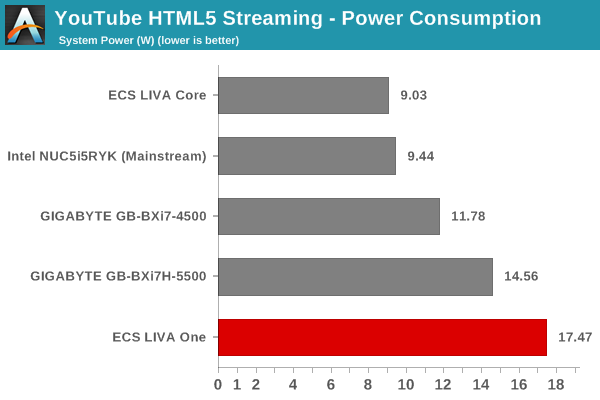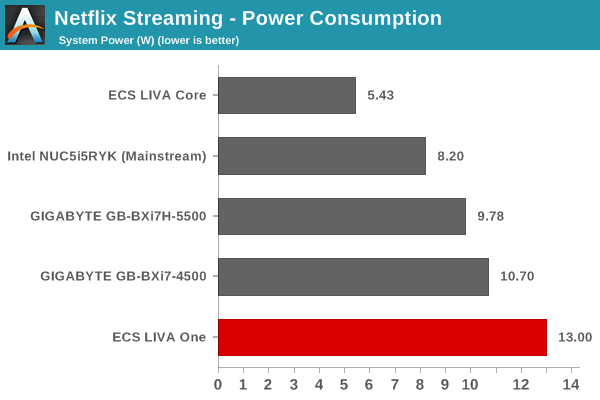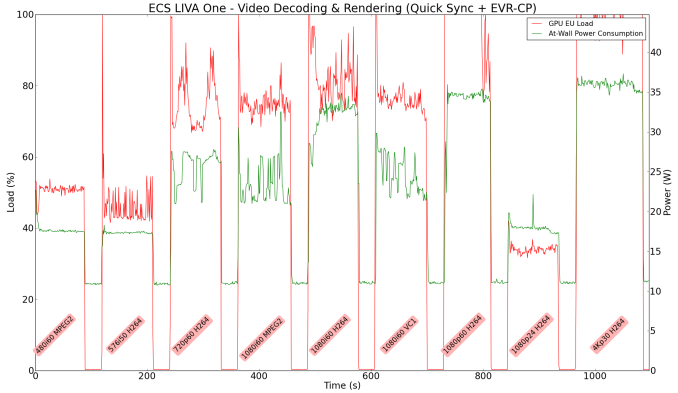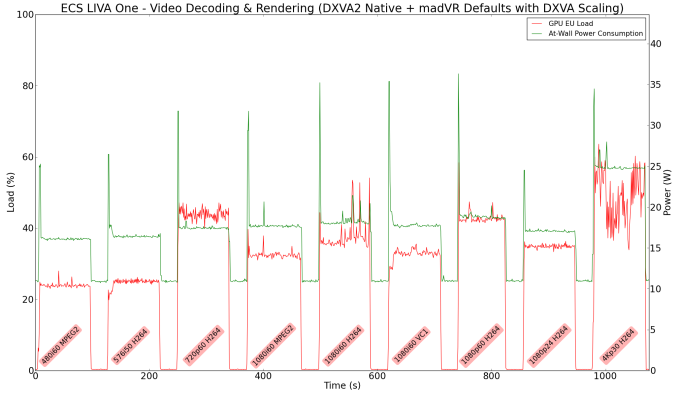ECS LIVA One Skylake mini-PC Review
by Ganesh T S on February 1, 2016 8:00 AM ESTHTPC Credentials
Unlike the earlier LIVA units, the LIVA One is not fanless. However, the design and size are such that any noise from the internal fan is attenuated in a good manner. It might not be completely silent, but, subjectively speaking, it is a good enough solution for media playback in the average household. The media playback pipeline in Skylake is also much improved, leading to lower power consumption and fan noise for most HTPC activities. With the acoustics discussion out of the way, we now move on to the discussion of other HTPC aspects.
Refresh Rate Accurancy
Starting with Haswell, Intel, AMD and NVIDIA have been on par with respect to display refresh rate accuracy. The most important refresh rate for videophiles is obviously 23.976 Hz (the 23 Hz setting). As expected, the ECS LIVA One has no trouble with refreshing the display appropriately in this setting.
The gallery below presents some of the other refresh rates that we tested out. The first statistic in madVR's OSD indicates the display refresh rate.
Network Streaming Efficiency
Evaluation of OTT playback efficiency was done by playing back our standard YouTube test stream and five minutes from our standard Netflix test title. Using HTML5, the YouTube stream plays back a 1080p AVC encode. Since YouTube now defaults to HTML5 for video playback, we have stopped evaluating Adobe Flash acceleration. The following graph shows the power consumption at the wall for playback of the HTML5 stream in Mozilla Firefox (v 44.0).

Intel has not yet publicly released APIs to track the appropriate GPU loading for media decode use-cases. The current D3D Usage metric reported by various third-party tools all represent the EU load, which fails to give a proper picture of the overall system impact. In any case, the GPU EU load was around 45.63% for the YouTube HTML5 stream.
Netflix streaming evaluation was done using the Windows 10 Netflix app. Manual stream selection is available (Ctrl-Alt-Shift-S) and debug information / statistics can also be viewed (Ctrl-Alt-Shift-D). Statistics collected for the YouTube streaming experiment were also collected here. On the EU usage front, it was quite obvious that lower resolution streams resulted in more EU usage for upscaling purposes. For example, the 480p stream consumed an average of 20% of the EU resources, while the 576p stream consumed around 6.36%. After the start of playback of the 720p stream, EU usage dropped down to 2.67%. For the 1080p version, the EU usage was negligible (< 0.1%), since the playback was being done on a 1080p60 display.

Decoding and Rendering Benchmarks
Since the ECS LIVA One happens to be the first Skylake mini-PC we are reviewing, we paid extra attention to our local file playback benchmarks. Prior to discussing them in detail, let us take a look at the capabilities of Intel HD Graphics 530 as exposed by DXVA Checker. We already know from our discussion of Skylake's media capabilities that HEVC Main10 decode is implemented via hybrid acceleration (CPU + GPU). The report generated from the ECS LIVA One doesn't have surprises compared to what we reported in late August 2015 (except that VP9 gets a 4K decoding profile in the new drivers).
Coming back to our benchmarking, we evaluated playback of different test files in four different environments:
- MPC-HC 1.7.10 x86 with LAV Video Decoder 0.66.0 in DXVA 2 Native Mode with EVR-CP as the renderer
- MPC-HC 1.7.10 x86 with LAV Video Decoder 0.66.0 in Quick Sync Mode with EVR-CP as the renderer
- MPC-HC 1.7.10 x86 with LAV Video Decoder 0.66.0 in DXVA 2 Native Mode with madVR 0.90.3 as the renderer (default settings for all options except for DXVA2 Scaling)
- Kodi 16.0 RC 2 with all settings at default
In our earlier reviews, we focused on presenting the GPU loading and power consumption at the wall in a table (with problematic streams in bold). Starting with the Broadwell NUC review, we decided to represent the GPU load and power consumption in a graph with dual Y-axes. Nine different test streams of 90 seconds each were played back with a gap of 30 seconds between each of them. The characteristics of each stream are annotated at the bottom of the graph. Note that the GPU usage is graphed in red and needs to be considered against the left axis, while the at-wall power consumption is graphed in green and needs to be considered against the right axis.
Frame drops are evident whenever the GPU load consistently stays above the 85 - 90% mark. The graphs present some interesting information. We are primarily handicapped by the fact that the only GPU loading numbers that we can record using third-party tools is the EU load and not the load on the MFX (dedicated codec block) or other dedicated video post processing units.
In the DXVA2 native mode, we believe the decoding is not an issue at all four our test streams. However, the post-processing comes into focus a bit. With deinterlacing and upscaling requirements (480i60 to 1080p60), it seems as if the EUs are oversubscribed by the EVR-CP renderer. At this point of time, I am not sure if the drivers are to blame, or the EVR-CP renderer code needs to adapt itself to Skylake. We have had numerous Intel iGPU systems from before that have had no trouble deinterlacing and upscaling 480i60 content to 1080p60.
The Quick Sync decode mode with EVR-CP, on the other hand, doesn't exhibit the deinterlacing / upscaling issue for 480i60 content. This could be due to deinterlacing being completely out of the hands of the EUs in this particular setup. However, the high frame rate content, for some reason, seems to stress the EUs more. 1080p60 and 4Kp30 were unwatchable with heavy frame drops in this setup. Again, we believe it is more of an issue with the drivers / software, rather than the hardware itself.
madVR, with DXVA scaling, on the other hand, works beautifully for almost all our test streams. The only exception was the 4Kp30 stream which had frequent frame drops. The EU loading doesn't seem to indicate any issues, and we believe with more careful tuning of the madVR options, it should be possible to get flawless playback of the 4Kp30 content also using this configuration.
Kodi 16.0 RC 2 has no issues with any of our test streams. Obviously, in the default configuration, it doesn't provide good deinterlacing or other post processing options like madVR or, even, EVR-CP. However, it suffices for most casual users.
On the whole, media playback is a bit of a mixed bag with respect to the Skylake platform in the ECS LIVA One. Drivers might need fixing, while ths software might also need to evolve appropriately.
One of the aspects I wish to clarify in our video decoding and rendering benchmarks is the absence of any HEVC clips in our test suite. In addition to waiting for widespread adoption (i.e, the licensing issues currently being played out with the MPEG-LA, HEVC Advance and others), we also want to coincide HEVC playback evaluation with a shift in our HTPC testbed from a 1080p display to a 4K one.





















30 Comments
View All Comments
watzupken - Monday, February 1, 2016 - link
I thought Airmont is Intel Cherry Trail?watzupken - Monday, February 1, 2016 - link
Asking because this is the specifications you've mentioned.Intel Core i3-6100T
(2C/4T Airmont x86 @ 3.2 GHz, 14nm, 3 MB L2, 35W TDP)
alpha64 - Monday, February 1, 2016 - link
You are right, this is Skylake, not Airmont. Check the wikipedia entry for Silvermont, and you will see the Airmont is a die shrink of Silvermont, and the list of CPUs that are Airmont are also listed (and this is not one of them).DanNeely - Monday, February 1, 2016 - link
If it's Monday, it's a copy/paste fail from reusing the table from an old article as a template. *sigh*ganeshts - Monday, February 1, 2016 - link
Apologies for the massive FAIL :| Fixed it now. Yes, the tables are templated, and this particular line skipped past the update.DanNeely - Monday, February 1, 2016 - link
This's happened enough times in one review or another, that there really should be a less errorprone way than starting with the last review and using it as a template.DJMiggy - Tuesday, February 2, 2016 - link
Stop being human ganeshts! ;)ToTTenTranz - Monday, February 1, 2016 - link
First table shows the Core i3 having Airmont cores. It's a Skylake CPU, as shown everywhere else in the article.nirolf - Monday, February 1, 2016 - link
It has a fan. Move along, nothing to see here.BrokenCrayons - Monday, February 1, 2016 - link
I'd prefer a fanless system as well, but in this case, I don't think it's possible to do so inexpensively using a 35 watt processor.I'd also prefer if ECS would reconsider shipping with a single 8GB DIMM and switch to a pair of 4GB DIMMs in order to enable dual channel. I realize there's a price point to hit, but when you're depending on a system's iGPU, the extra memory channel is helpful. I'd not like buying a new system only to have to start looking at the purchase of additional parts right away to get the most out of it.